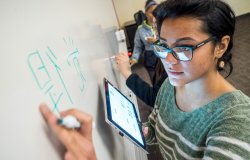What is Authentic Assessment?
Assessment is authentic when we directly examine student performance on worthy intellectual tasks.
Authentic assessments measure student learning through real-world tasks or meaningful application of knowledge or skills. These typically take the form of a project or product of some sort. This stands in contrast with traditional assessments, such as exams or tests, that tend to only rely on recalling and reciting information in ways that can often be oversimplified and/or decontextualized from their usage in the field.
While some definitions vary, a study of authentic assessment literature by Villarroel et. al. (2017) identified three key domains of authentic assessments:
- Higher-order thinking and application of knowledge.
- Emulation of real-world situations in a particular field or industry.
- Opportunities to justify, challenge, and revise.
Higher-order thinking
Authentic assessments align with the higher-order domains of Bloom’s Taxonomy (Analyze, Evaluate, and Create). It is not simply enough to recall information or recognize a correct answer (such as on an exam); students must be able to demonstrate a deeper understanding by using this information in transformative ways.
Real-world situations
Authentic assessments highlight the responsibilities or duties of professionals within a given discipline and how the knowledge learned in class applies to a real-world situation, often bridging the gap between theoretical knowledge and practical application (answering the question of “why does this matter?” or “why do I need to know this?”).
Challenge, Justify, Revise
Authentic assessments also require students to justify their decisions and, if a decision is made that does not work, revise them. Strategies such as peer review or critiques during the development process allow students to provide a rationale for their approach and decision-making. Afterward, students are able to reflect on new information, ideas, or possible oversights, and make adjustments to better reflect their new understanding.
However, authentic assessment design does take a degree more of intentionality when building than a traditional assessment, and thus may be harder to easily and quickly create than a series of test questions. Similarly, while Canvas-based exams can be automatically graded, authentic assessments require the instructor to individually evaluate each student. Helping in this evaluative process, rubrics are an invaluable tool, as they allow instructors to clearly define a set of success criteria that a student’s submission will be weighed against.
That said, research shows that when using authentic assessment methodology, student learning outcomes and intrinsic motivation are considerably higher (Colthorpe et. al., 2020), while the likelihood of academic dishonesty (plagiarism, cheating) tends to be reduced.
Examples of Authentic Assessment
Some examples of authentic assessments can be found below. Notice the common thread in all of these examples is that, for an individual working in the field, this could be a realistic responsibility or task they may encounter. This is the “authentic” aspect.
Nutrition or Exercise Science
In a nutrition or exercise science course, it could take the form of developing a patient care plan for a client in order to reach their specified goals, requiring students to understand how nutrition and exercise regimens need to be modified in response to an individual’s physiology to achieve a desired outcome.
Environmental Science
In an environmental science course, it could be deciding on natural ways to mitigate flooding in response to a changing climate in an area that has recently seen issues with floods, requiring students to consider how the ecosystem functioning of the region has been altered by development and how it contributes to floods, then finding solutions that may help restore some original function of that environment.
Education
In an education course, an authentic assessment could be designing an IEP for a student with a particular set of needs, taking into account how children at the student’s age level learn and what their specific needs are, what challenges that student may have, and how to best support that child’s ability to succeed.
Computer Science
In a computer science course, students could be tasked with developing a program or app to solve a mundane task, such as a rotating schedule of household chores for a family, a nightly meal planner, etc., requiring them to understand how different programming functions work together with user input to return a desired output.
Business Management
In a business course, the authentic assessment task may be to develop a plan to support a company that is failing for a number of reasons, where students may need to look at the company’s organizational and management structure, financial strategy, Human Resources reports, or other areas of a company to identify the changes necessary for course correction and success.
- Wiggins, Grant (1990). The case for authentic assessment. Practical Assessment, Research & Evaluation, 2(2). Available online: http://PAREonline.net/getvn.asp?v=2&n=2 .
- Verónica Villarroel, Susan Bloxham, Daniela Bruna, Carola Bruna & Constanza Herrera-Seda (2018) Authentic assessment: creating a blueprint for course design, Assessment & Evaluation in Higher Education, 43:5, 840-854, DOI: 10.1080/02602938.2017.1412396
- Kay Colthorpe, Harrison Gray, Louise Ainscough & Hardy Ernst (2021) Drivers for authenticity: student approaches and responses to an authentic assessment task, Assessment & Evaluation in Higher Education, 46:7, 995-1007, DOI: 10.1080/02602938.2020.1845298
- Noel M. Meyers & Duncan D. Nulty (2009) How to use (five) curriculum design principles to align authentic learning environments, assessment, students’ approaches to thinking and learning outcomes, Assessment & Evaluation in Higher Education, 34:5, 565-577, DOI: 10.1080/02602930802226502
- Faculty Focus: Alternative Assessment Methods for the Online Classroom
